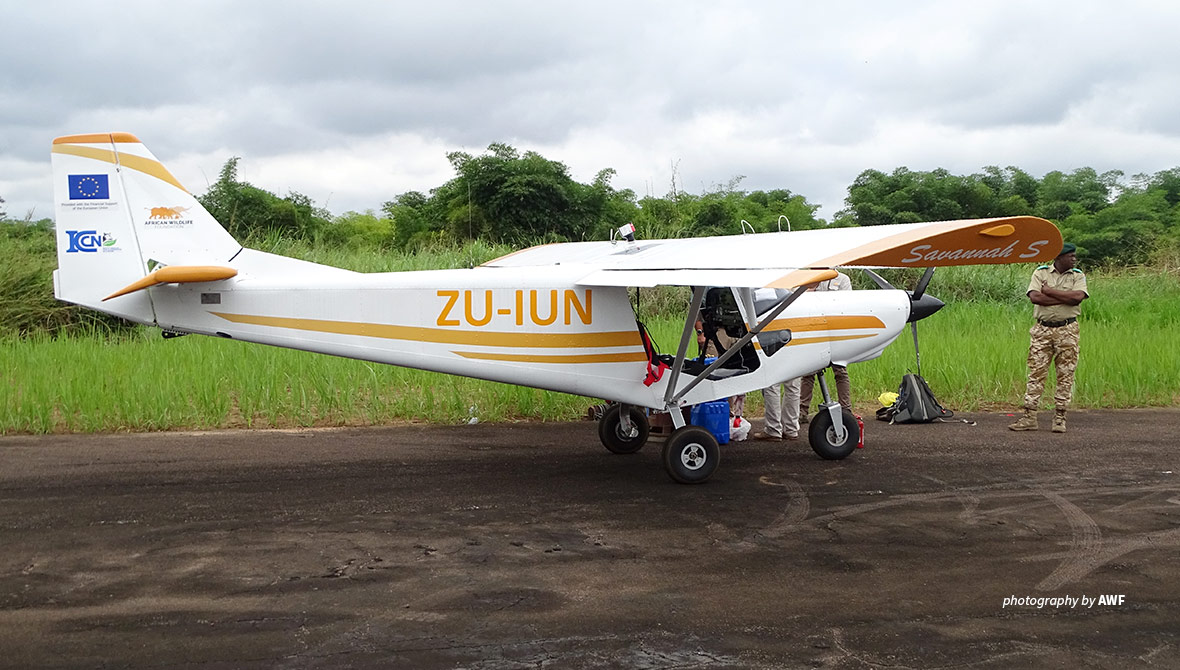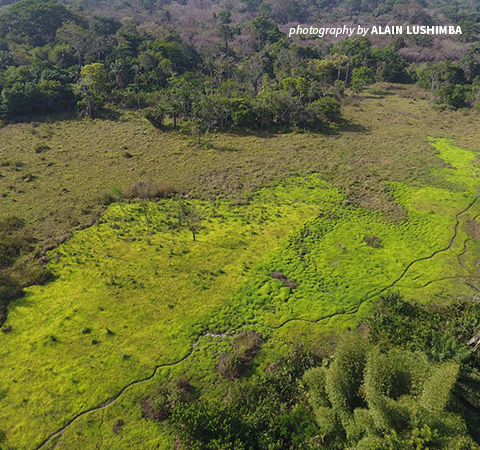A small airplane opens Bili Uele’s remote forests to conservation

In October 2021, a new aircraft was delivered to the African Wildlife Foundation office in Bili Uele in the Democratic Republic of Congo. This plane will be integral to the continued operations and logistics in this expansive forest landscape where travel is fraught, impeded by poor road networks and vast distances.
AWF purchased the aircraft with the support of the European Union under the Preserving Biodiversity and Fragile Ecosystems in Central Africa program. Also known as ECOFAC 6, this program aims to improve conservation management and governance of the Bili Mbomu Core Conservation Area for the benefit of both wildlife and people. It is a collaboration between AWF and l’Institut Congolais pour la Conservation de la Nature, Maisha Consulting, and law enforcement partner JURISTRALE to implement conservation initiatives including ecological monitoring, anti-poaching patrols, sustainable livelihood development, and land-use planning in and around the protected area.
In this eye-opening interview, AWF’s former Chief Technical Advisor for Bili Uele, Matthew Bowen, describes what it is like to fly in the new plane and how the field office will use it to continue securing conservation outcomes in the landscape.
Why did AWF procure a plane for wildlife conservation, and how was the journey to Bili Uele?
The arrival at the aircraft’s new home of Bili was met with excitement by the local chiefs, who blessed the plane and welcomed it into their territory with a traditional ceremony. This was definitely the highlight of the whole trip. I joined the pilot upon the plane’s arrival into the DRC at Goma. We did a first flight into Virunga National Park to see how they operated their airplanes and for a technical check of the plane after its arduous flight up from South Africa. Because the Savannah-S is such a small aircraft (classed as ULM - Ultra Light Motorised), it is very difficult to travel long distances and quite daunting to fly in for the first time — it almost feels like you are riding a motorbike in the air. It was such an exciting moment when it finally arrived in the Bili landscape.
What was the process of procuring and delivering the aircraft to Bili?
We took the first steps to procure the plane in 2019, after a European Union delegation visit to the landscape, when the necessity of an aircraft was clearly seen first-hand. We looked at what type of planes were being used by other conservation NGOs, and once our decision was approved, we placed the order. Unfortunately, this coincided with the arrival of the COVID-19 pandemic, and everything was put on hold. Eventually, construction of the plane kicked off at the beginning of 2021, and after flight trials, certification, and the procurement of a pilot, we were finally ready to go.
Then the logistical challenges of flying the plane up from South Africa, via Zimbabwe, Malawi, Tanzania, and Burundi — then into and across the DRC began. This was by far the biggest challenge, as we had to find places to land that could supply fuel within the aircraft’s fuel capacity. On top of that, crossing into the DRC meant flying between the mountain ranges, as the plane was unable to climb high enough to cross directly over them. The entire trip, from the factory in East London, South Africa to Bili took around 12 flying days but there were a couple of stopovers in Harare and Goma before we finally made it to Bili.

Aerial view of Bili Uele's forest landcape
What makes wildlife conservation in the Bili Uele landscape difficult?
The most obvious and biggest logistical challenge is the fact that the DRC is so vast and access into remote areas, such as the Bili landscape — where AWF and the wildlife authority’s conservation base is located — is very challenging and limited — sometimes impossible at certain times of the year. This restricts our biomonitoring work, seeing as eco-guards are not able to venture far enough into the protected area to capture information about wildlife or gather intelligence for security operations.
In addition, the importation of big items into Bili is difficult, as the road that vehicles can use is only open during the dry season and small bridges mean that we can sometimes be limited by weight and size. Big containers and large trucks cannot use this route, so we have to break loads down to fit into our Land Cruisers and small 4x4 trucks for the trip by road to Bili. We would need a much bigger plane to address this particular challenge!
What is the first trip of the Sahara-S aircraft after it arrived in Bili?
The plane’s first assignment is to fly around the protected area and check on alternative airstrips and mark them on the plane’s GPS. If, for example, we are unable to land back at Bili due to bad weather, we can locate alternative landing sites. This is critical for the safety of the plane and the aircrew.
How will the plane improve AWF’s wildlife conservation initiatives in Bili?
The plane will certainly allow us to visit parts of the landscape that we could not get to for a long time due to the difficulty of access by foot. This will enable us to see and photograph wildlife in the expansive Bili Uele landscape, which is difficult to do whilst on the ground and will improve our collection of biomonitoring information. The aerial view will also help us complement our eco-guard patrols by feeding them back security information on what we see from above to strengthen and streamline our fight against poaching activities.